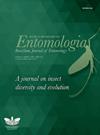1775年食水甲虫雄性生殖道形态特征(鞘翅目:亲水甲虫科)
IF 0.7
4区 农林科学
Q4 ENTOMOLOGY
引用次数: 1
摘要
摘要水生昆虫科是最大的水生昆虫科之一,其成员是淡水栖息地和全球气候变化生物监测的潜在模式。在本研究中,我们描述了食水甲虫Tropsternus collais雄性生殖道的形态。性成熟男性的生殖道包括一对睾丸,每个睾丸至少有30个卵泡、输精管传出、输精管、精囊、两对附属腺(一对豆状腺和一对分叉的管状腺)和一根射精管。鞘翅目分类群之间的特征不同,如睾丸卵泡和附属腺的数量,以及它们的形状、起源和分泌类型,有可能帮助阐明该类群的繁殖策略和进化史。本文章由计算机程序翻译,如有差异,请以英文原文为准。
Morphology of the male reproductive tract in the water scavenger beetle Tropisternus collaris Fabricius, 1775 (Coleoptera: Hydrophilidae)
ABSTRACT Members of the Hydrophilidae, one of the largest families of aquatic insects, are potential models for the biomonitoring of freshwater habitats and global climate change. In this study, we describe the morphology of the male reproductive tract in the water scavenger beetle Tropisternus collaris. The reproductive tract in sexually mature males comprised a pair of testes, each with at least 30 follicles, vasa efferentia, vasa deferentia, seminal vesicles, two pairs of accessory glands (a bean-shaped pair and a tubular pair with a forked end), and an ejaculatory duct. Characters such as the number of testicular follicles and accessory glands, as well as their shape, origin, and type of secretion, differ between Coleoptera taxa and have potential to help elucidate reproductive strategies and the evolutionary history of the group.
求助全文
通过发布文献求助,成功后即可免费获取论文全文。
去求助
来源期刊
CiteScore
1.50
自引率
12.50%
发文量
14
审稿时长
6-12 weeks
期刊介绍:
Information not localized

 求助内容:
求助内容: 应助结果提醒方式:
应助结果提醒方式:


